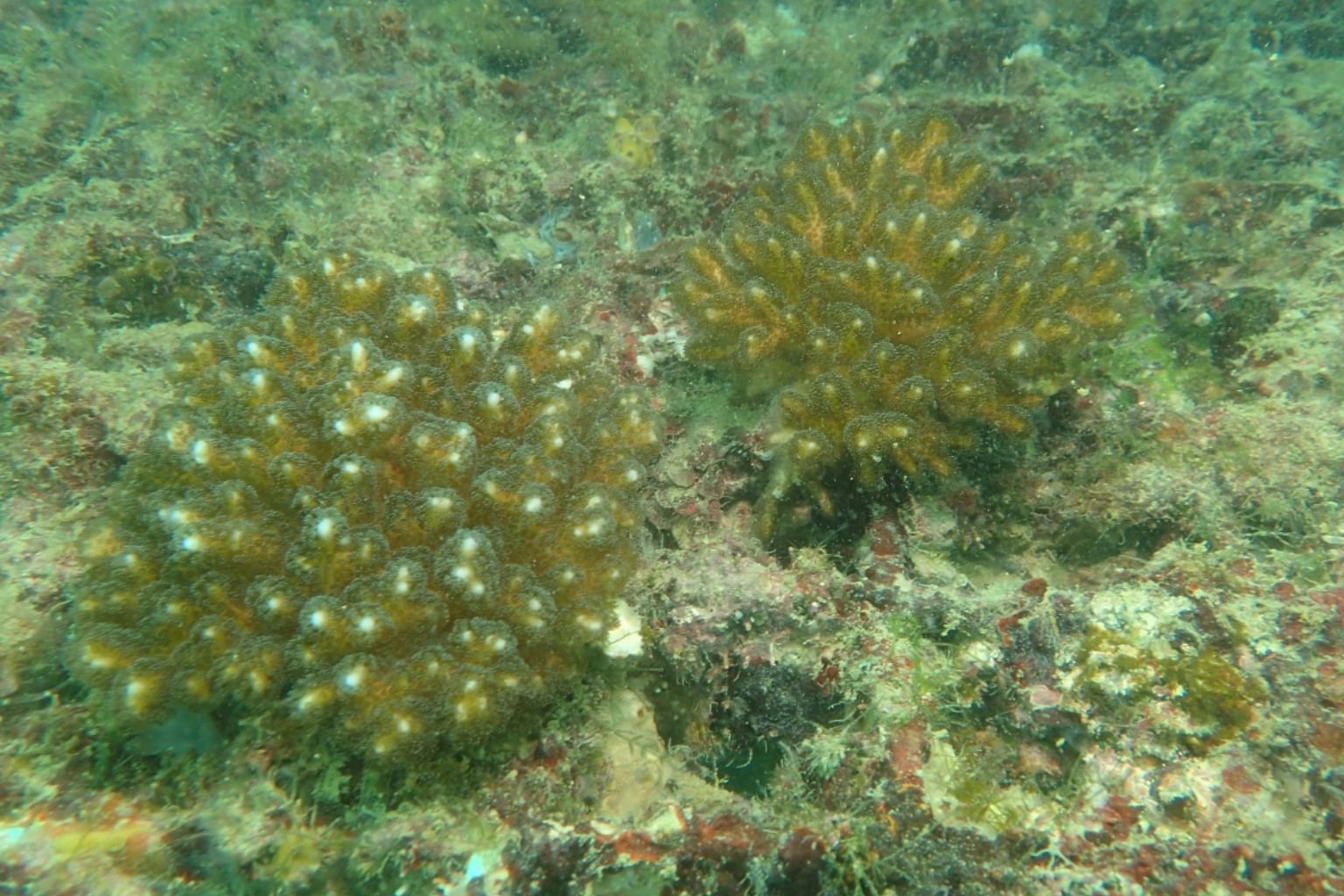Corals blossom from artificial reef structures sunk in 2018 on seabed off Sisters' Islands
Sign up now: Get ST's newsletters delivered to your inbox

A hard coral growing on an artificial reef in September 2020.
PHOTO: NPARKS
Follow topic:
SINGAPORE - Eight coral "planter boxes" - structures up to 10m tall made of concrete and fibreglass - placed in 2018 on the seabed off Sisters' Islands are now showing encouraging signs of life.
Corals cover the fibreglass panels and concrete surfaces at the top 2m to 3m of the structure, where light still streams through, while fish can be found swimming around the structures at deeper, darker depths.
The mission to coax a coral reef garden to bloom from bareness is off to a good start.
Dr Karenne Tun, director at the National Parks Board's (NParks) National Biodiversity Centre, said in an update in September: "Now that we have seen corals naturally (settling) on the artificial reef structures, we hope to see an increase in the number of species and the number of colonies that utilise the space.
"It is heartening to see a wide variety of fishes using the artificial reef structures almost immediately after deployment."
She added: "Close to four years after the deployment of the artificial reef structures, we continue to observe a good diversity of fish species within and around the structures and the adjacent coral reefs."
National University of Singapore (NUS) fish scientist Zeehan Jaafar said the artificial reef structures are significant in size and height, and these traits tend to draw fish looking for prey or refuge to them.
The eight artificial reef structures were sunk in 2018 by NParks and industrial developer JTC on the bare, sandy seabed off Small Sisters' Island - which is part of the Sisters' Islands Marine Park. The aim is to enhance Singapore's marine habitats and contribute to marine conservation.
When the corals grow, the artificial reef structures are expected to contribute about 1,000 sq m - more than 10 times the floor area of a four-room Housing Board flat - of additional reef substrate to the Sisters' Islands Marine Park.
Coral reefs in Singapore can be found mainly in Singapore's southern waters, where the Sisters' Islands Marine Park is located.
These tropical marine habitats host a great diversity of life. In Singapore, coral reefs have provided refuge for baby fish, sea slugs and even critically endangered species such as the hawksbill turtle.
Of the eight artificial reef structures, six of them had been affixed with 1,933 coral colonies from 43 hard coral genera - or types of corals - transplanted from other locations in Singapore between September 2020 and February 2021.
But more of them were spotted in February 2022, with 1,961 live coral colonies from 43 hard coral genera found at designated survey plots on the structures, said Dr Tun. These include coral larvae that had naturally settled on the structures.
For the other two structures that had no coral colonies transplanted onto them, surveys showed that in February 2022, 95 coral colonies from seven hard coral genera had naturally settled onto the survey plots on the artificial reefs.
Dr Tun said corals were observed to settle naturally on the reef structures only about two years after they were first deployed.
"We observed that the initial colonists were encrusting barnacles and bivalves (shellfish)... This is not unusual as nature will determine what is the best combination of factors suitable for its constituents to thrive," she added.
There are many factors that influence coral recruitment, including water quality, availability of coral larvae, the type and availability of substrate - or surfaces that larvae can settle on - as well as a suitable biofilm community, she added.
Micro-organisms are typically the earliest colonisers and form a thin biofilm that encourages further settlement by larger organisms such as corals.

NUS Assistant Professor Huang Danwei said: "The shells (of the barnacles and bivalves) also serve as substrates on which coral larvae are encouraged to settle. Together, the biofilm and initial colonisers may also release chemical compounds for coral larvae to home in on the artificial structures and to settle."
The marine biologist, who heads the Reef Ecology Laboratory at NUS, said it was an encouraging sign that there has been a general increase in the number of colonies growing on the artificial structures.
"The artificial reefs created by NParks and JTC generate new surfaces and substrates in areas where no reefs would have been growing in the first place," he said.
"They are placed adjacent to, but not on, an existing reef site, so they attract biodiversity from healthy reefs and produce more space for biodiversity to thrive and reproduce."
NParks' Dr Tun said prior studies have shown that the Sisters' Islands Marine Park is both a source and sink habitat - meaning the site receives marine organisms from elsewhere, and is also where larvae disperse from.
"Placing the artificial reef structures within the marine park will assist with the repopulation of corals there, and serve as a source of corals that could disperse and regenerate other coral populations in the Southern Islands," she added.

